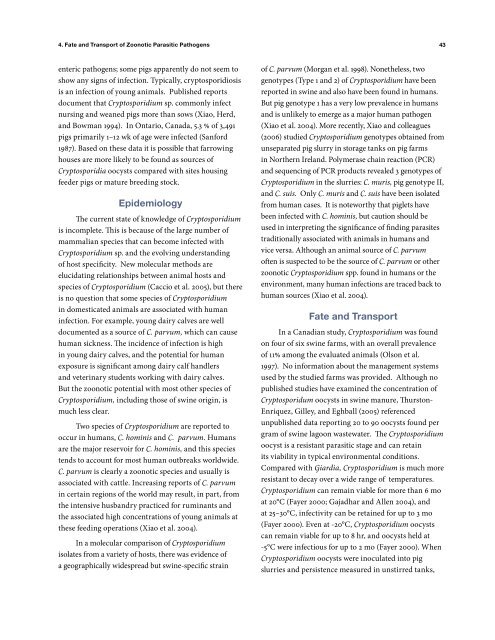Fate and Transport of Zoonotic Bacterial, Viral, and - The Pork Store ...
Fate and Transport of Zoonotic Bacterial, Viral, and - The Pork Store ...
Fate and Transport of Zoonotic Bacterial, Viral, and - The Pork Store ...
Create successful ePaper yourself
Turn your PDF publications into a flip-book with our unique Google optimized e-Paper software.
4. <strong>Fate</strong> <strong>and</strong> <strong>Transport</strong> <strong>of</strong> <strong>Zoonotic</strong> Parasitic Pathogens<br />
enteric pathogens; some pigs apparently do not seem to<br />
show any signs <strong>of</strong> infection. Typically, cryptosporidiosis<br />
is an infection <strong>of</strong> young animals. Published reports<br />
document that Cryptosporidium sp. commonly infect<br />
nursing <strong>and</strong> weaned pigs more than sows (Xiao, Herd,<br />
<strong>and</strong> Bowman 1994). In Ontario, Canada, 5.3 % <strong>of</strong> 3,491<br />
pigs primarily 1–12 wk <strong>of</strong> age were infected (Sanford<br />
1987). Based on these data it is possible that farrowing<br />
houses are more likely to be found as sources <strong>of</strong><br />
Cryptosporidia oocysts compared with sites housing<br />
feeder pigs or mature breeding stock.<br />
Epidemiology<br />
<strong>The</strong> current state <strong>of</strong> knowledge <strong>of</strong> Cryptosporidium<br />
is incomplete. This is because <strong>of</strong> the large number <strong>of</strong><br />
mammalian species that can become infected with<br />
Cryptosporidium sp. <strong>and</strong> the evolving underst<strong>and</strong>ing<br />
<strong>of</strong> host specificity. New molecular methods are<br />
elucidating relationships between animal hosts <strong>and</strong><br />
species <strong>of</strong> Cryptosporidium (Caccio et al. 2005), but there<br />
is no question that some species <strong>of</strong> Cryptosporidium<br />
in domesticated animals are associated with human<br />
infection. For example, young dairy calves are well<br />
documented as a source <strong>of</strong> C. parvum, which can cause<br />
human sickness. <strong>The</strong> incidence <strong>of</strong> infection is high<br />
in young dairy calves, <strong>and</strong> the potential for human<br />
exposure is significant among dairy calf h<strong>and</strong>lers<br />
<strong>and</strong> veterinary students working with dairy calves.<br />
But the zoonotic potential with most other species <strong>of</strong><br />
Cryptosporidium, including those <strong>of</strong> swine origin, is<br />
much less clear.<br />
Two species <strong>of</strong> Cryptosporidium are reported to<br />
occur in humans, C. hominis <strong>and</strong> C. parvum. Humans<br />
are the major reservoir for C. hominis, <strong>and</strong> this species<br />
tends to account for most human outbreaks worldwide.<br />
C. parvum is clearly a zoonotic species <strong>and</strong> usually is<br />
associated with cattle. Increasing reports <strong>of</strong> C. parvum<br />
in certain regions <strong>of</strong> the world may result, in part, from<br />
the intensive husb<strong>and</strong>ry practiced for ruminants <strong>and</strong><br />
the associated high concentrations <strong>of</strong> young animals at<br />
these feeding operations (Xiao et al. 2004).<br />
In a molecular comparison <strong>of</strong> Cryptosporidium<br />
isolates from a variety <strong>of</strong> hosts, there was evidence <strong>of</strong><br />
a geographically widespread but swine-specific strain<br />
<strong>of</strong> C. parvum (Morgan et al. 1998). Nonetheless, two<br />
genotypes (Type 1 <strong>and</strong> 2) <strong>of</strong> Cryptosporidium have been<br />
reported in swine <strong>and</strong> also have been found in humans.<br />
But pig genotype 1 has a very low prevalence in humans<br />
<strong>and</strong> is unlikely to emerge as a major human pathogen<br />
(Xiao et al. 2004). More recently, Xiao <strong>and</strong> colleagues<br />
(2006) studied Cryptosporidium genotypes obtained from<br />
unseparated pig slurry in storage tanks on pig farms<br />
in Northern Irel<strong>and</strong>. Polymerase chain reaction (PCR)<br />
<strong>and</strong> sequencing <strong>of</strong> PCR products revealed 3 genotypes <strong>of</strong><br />
Cryptosporidium in the slurries: C. muris, pig genotype II,<br />
<strong>and</strong> C. suis. Only C. muris <strong>and</strong> C. suis have been isolated<br />
from human cases. It is noteworthy that piglets have<br />
been infected with C. hominis, but caution should be<br />
used in interpreting the significance <strong>of</strong> finding parasites<br />
traditionally associated with animals in humans <strong>and</strong><br />
vice versa. Although an animal source <strong>of</strong> C. parvum<br />
<strong>of</strong>ten is suspected to be the source <strong>of</strong> C. parvum or other<br />
zoonotic Cryptosporidium spp. found in humans or the<br />
environment, many human infections are traced back to<br />
human sources (Xiao et al. 2004).<br />
<strong>Fate</strong> <strong>and</strong> <strong>Transport</strong><br />
In a Canadian study, Cryptosporidium was found<br />
on four <strong>of</strong> six swine farms, with an overall prevalence<br />
<strong>of</strong> 11% among the evaluated animals (Olson et al.<br />
1997). No information about the management systems<br />
used by the studied farms was provided. Although no<br />
published studies have examined the concentration <strong>of</strong><br />
Cryptosporidum oocysts in swine manure, Thurston-<br />
Enriquez, Gilley, <strong>and</strong> Eghball (2005) referenced<br />
unpublished data reporting 20 to 90 oocysts found per<br />
gram <strong>of</strong> swine lagoon wastewater. <strong>The</strong> Cryptosporidium<br />
oocyst is a resistant parasitic stage <strong>and</strong> can retain<br />
its viability in typical environmental conditions.<br />
Compared with Giardia, Cryptosporidium is much more<br />
resistant to decay over a wide range <strong>of</strong> temperatures.<br />
Cryptosporidium can remain viable for more than 6 mo<br />
at 20°C (Fayer 2000; Gajadhar <strong>and</strong> Allen 2004), <strong>and</strong><br />
at 25–30°C, infectivity can be retained for up to 3 mo<br />
(Fayer 2000). Even at -20°C, Cryptosporidium oocysts<br />
can remain viable for up to 8 hr, <strong>and</strong> oocysts held at<br />
-5°C were infectious for up to 2 mo (Fayer 2000). When<br />
Cryptosporidium oocysts were inoculated into pig<br />
slurries <strong>and</strong> persistence measured in unstirred tanks,<br />
43


